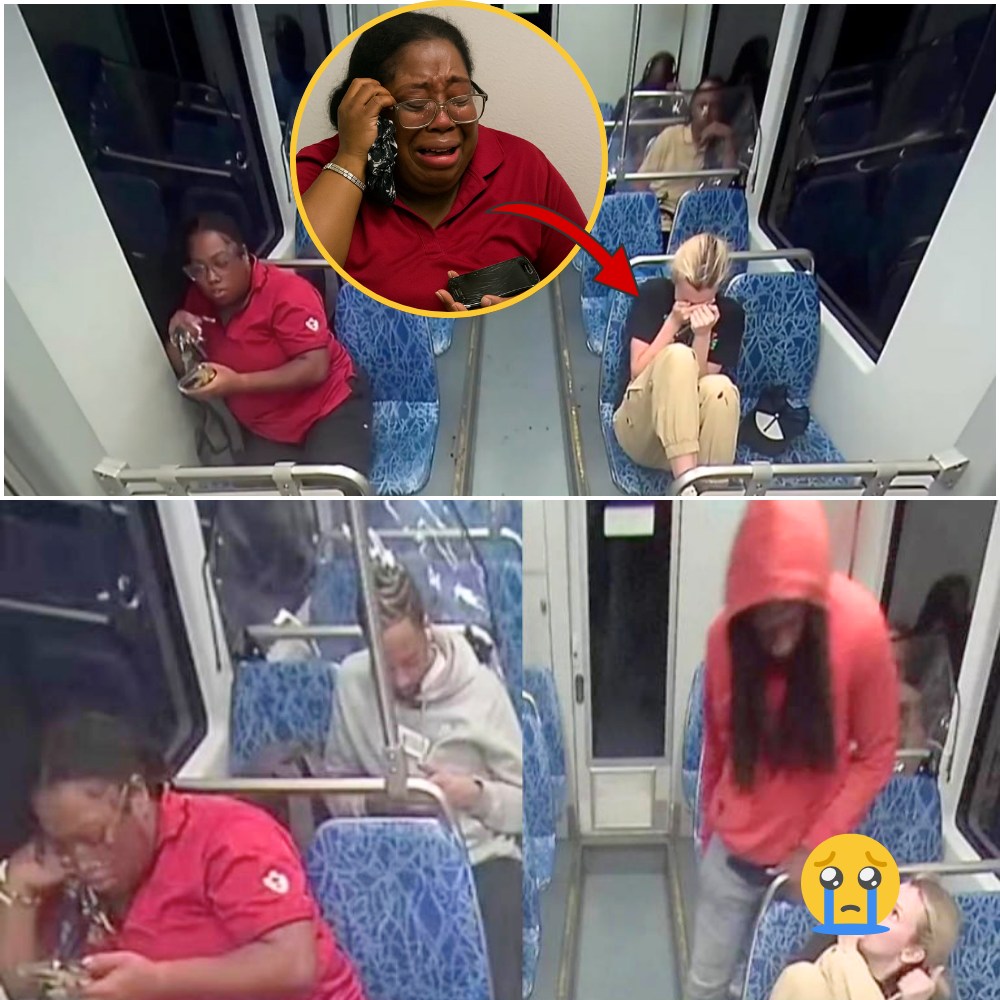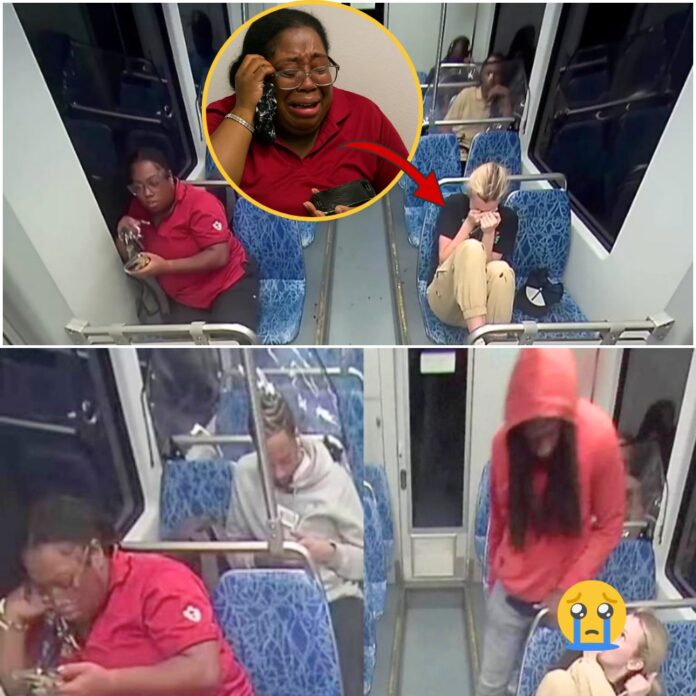![]() Shocking Indifference: Passengers Unaware as Iryna Zarutska Was Stabbed on Train
Shocking Indifference: Passengers Unaware as Iryna Zarutska Was Stabbed on Train ![]()
![]() …
…

On the evening of August 22, 2025, Iryna Zarutska, a 23-year-old Ukrainian refugee who had escaped the horrors of war, boarded the Lynx Blue Line in Charlotte, North Carolina, after a long shift at a South End pizzeria. At approximately 9:50 p.m., as the train glided through the city’s glittering South End district, a fellow passenger, Decarlos Brown Jr., 34, pulled a pocketknife from his hoodie and stabbed her three times from behind—once in the shoulder, once in the back, and a fatal blow to the neck. Zarutska bled out on the train floor, her life extinguished in seconds. Yet, in a chilling detail that has stunned the nation, surveillance footage reveals that nearby passengers, absorbed in their phones or lost in their own worlds, remained unaware of the attack until her body slumped forward and screams pierced the car.
The footage, released by the Charlotte Area Transit System (CATS) on September 5, has sparked a national outcry—not only over the brutality of the crime but also over the apparent indifference of those aboard the train. In a nation grappling with rising urban violence and debates over public safety, Zarutska’s death has become a grim symbol of a society too distracted to notice a life slipping away. The case has reignited discussions about bystander apathy, the role of technology in desensitizing us, and the vulnerabilities of public transit systems in American cities.
A Life Cut Short
Iryna Zarutska’s story is one of resilience and hope abruptly ended. Born on May 22, 2002, in Kyiv, Ukraine, she grew up amidst the chaos of the Russian invasion that began in 2022. A graduate of Synergy College with a degree in Art and Restoration, Zarutska was known for her vibrant sketches and infectious optimism. After enduring months of bombings, she and her family fled to Poland, then resettled in Charlotte in 2023, seeking safety and a fresh start. In the U.S., she quickly adapted, mastering English, enrolling in community college, and working late shifts to support her loved ones. Her Instagram posts, filled with snapshots of Charlotte’s skyline and captions like “Chasing dreams in a new home,” painted a picture of a young woman embracing her second chance.
On that fateful night, Zarutska texted her boyfriend, Dmytro Kovalenko, at 9:30 p.m., saying she was heading home soon. She boarded the Blue Line at Scaleybark station, settling into an aisle seat near the back of a moderately crowded car. Surveillance footage shows her engrossed in her phone, likely scrolling through messages or social media, unaware of Brown seated behind her. The video, which has since gone viral, captures the next four minutes: passengers around her stare at their screens, earbuds in, or gaze out windows, while Brown calmly retrieves his knife and strikes. The attack is swift—less than five seconds from first blow to last. Only after Zarutska’s body collapses, blood pooling, do nearby riders react, some screaming, others scrambling to the opposite end of the car.
The Bystander Effect in Real Time
The lack of immediate reaction has shocked viewers and drawn comparisons to infamous cases of bystander inaction, like the 1964 Kitty Genovese murder in New York City. “This is the bystander effect on steroids,” said criminologist James Alan Fox of Northeastern University in a September 25 interview with Fox News. “In a confined space like a train, you’d expect someone to notice a knife being drawn, but technology has created bubbles around us.” The footage shows at least eight passengers within 10 feet of Zarutska, yet none appear to register the threat until it’s too late. One woman, later identified in court documents as a 29-year-old nurse, told police she was watching a Netflix show with noise-canceling headphones and only looked up when another rider yelled. A teenage boy, seated diagonally across, admitted to texting friends, oblivious to the attack.
Social media has been unforgiving. “People were too busy with TikTok to save a life,” read one viral X post from user @CarolinaTruth on September 15, garnering 20,000 likes. Another user, @JusticeNowNC, wrote, “This is what happens when we’re all zombies on our phones. RIP Iryna.” The hashtags #TrainTragedy and #WakeUpAmerica have trended alongside #IrynasLaw, reflecting a mix of grief and frustration. Some posts, however, have cautioned against victim-blaming passengers, with @CLTUnity arguing, “They didn’t know what was happening. The real issue is why a repeat offender was free to kill.”
A Suspect with a Troubled Past
Decarlos Brown Jr., arrested minutes after the attack as he tried to flee the train, faces federal charges for committing an act causing death on a mass transportation system—a crime that could carry the death penalty. Court records reveal a troubling history: 14 arrests since 2007, including convictions for armed robbery, assault with a deadly weapon, and felony larceny. Released on bail for a shoplifting charge in June 2025, Brown had documented struggles with schizophrenia and substance abuse. His sister, Tracey Brown, told WBTV on September 20, “He wasn’t evil—he was sick. The system let him slip through.” Prosecutors, however, call the attack “random and unprovoked,” with no evidence Zarutska and Brown had any prior interaction.
The U.S. Department of Justice, which elevated the case to federal jurisdiction on September 9, is examining surveillance and phone data to establish a timeline. Brown’s competency hearing is scheduled for October 15, with his defense team signaling a push for mental health evaluations over punitive measures. The case has fueled broader debates over bail reform, with conservative outlets like the New York Post arguing it exemplifies a “revolving door” justice system. A September 22 op-ed in the Post titled “Failed by the Courts: Iryna’s Blood on Soft-on-Crime Hands” cited U.S. Sentencing Commission data showing 63.8% of violent offenders reoffend post-release.
A City and Nation Respond
Charlotte Mayor Vi Lyles, a Democrat facing reelection pressure, has struggled to contain the fallout. In a September 26 statement, she announced enhanced security measures, including 50 new transit officers and real-time camera monitoring on all CATS trains. “This tragedy exposes gaps we’re working tirelessly to close,” Lyles said, though critics like City Councilman Edwin Peacock III accuse her of reactive posturing. “Passengers shouldn’t have to play hero because our leaders failed on prevention,” Peacock told Fox News on September 24.
Nationally, the case has amplified calls for transit safety reforms. The U.S. Department of Transportation, led by Secretary Sean Duffy, launched a probe into CATS on September 10, questioning its safety protocols. A forthcoming Government Accountability Office (GAO) report, expected in October, highlights staffing shortages and outdated systems plaguing urban transit nationwide. President Donald Trump, in a September 21 rally in Raleigh, referenced Zarutska’s death to blast “Democrat-run cities where chaos reigns,” promising federal funding for law enforcement.
North Carolina’s General Assembly passed “Iryna’s Law” on September 25, a bipartisan bill eliminating cashless bail for violent felonies and allocating $20 million for transit upgrades. Governor Josh Stein signed it into law on September 26, stating, “Iryna’s memory demands we act to protect every rider.” The law also mandates mental health screenings for repeat offenders, addressing Brown’s history.
A Family’s Grief and a Community’s Reflection
Zarutska’s family remains devastated. Her uncle, Oleh Zarutskyi, who traveled from Ukraine for a September 22 vigil, told reporters, “Iryna came here for safety, and we all failed her—passengers, police, everyone.” A GoFundMe for funeral costs and a scholarship in her name has raised over $300,000, with donors citing the bystander indifference as a call to action. Kovalenko, her boyfriend, shared a statement via attorneys: “She deserved someone to look up, to care. We need to be better.”
Experts point to deeper societal issues. Psychologist Dr. Pamela Rutledge, in a September 23 CNN interview, noted that smartphones create “attentional blindness,” reducing awareness of surroundings. “We’re wired to focus narrowly now,” she said. “It’s not malice—it’s human nature in a tech-driven world.” Urban planner Sarah Kaufman of NYU’s Rudin Center told the New York Times on September 20 that transit systems must adapt, suggesting panic buttons and AI-driven anomaly detection to alert distracted riders.
The indifference captured on video has spurred local initiatives. Charlotte’s “Eyes Up, Phones Down” campaign, launched September 24, urges riders to stay vigilant. Community groups have organized self-defense classes at transit hubs, and vigils continue, with a September 26 gathering at East/West Boulevard station drawing hundreds holding signs reading “See Something, Save Someone.”
A Lasting Wake-Up Call
As the investigation continues, the image of passengers unaware of Zarutska’s plight lingers as a stark warning. Was it a momentary lapse in a distracted age, or a deeper failure of community? For Iryna Zarutska, who survived war only to fall victim to urban violence, the answer came too late. Her death, and the inaction around it, challenges us to look up from our screens and reconnect with the world—and each other—before another life is lost.
